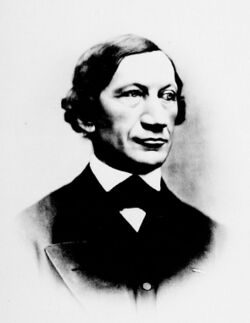Biography:Gustave-Adolphe Hirn
Gustave-Adolphe Hirn | |
|---|---|
 Photograph of Hirn c. 1884 – 1890 | |
| Born | 21 August 1815 Logelbach, Haut-Rhin, France[1] |
| Died | 14 January 1890 (aged 74) Colmar, Haut-Rhin, France[1] |
| Awards | Chevalier of the Légion d'Honneur (1865) |
| Scientific career | |
| Fields | Physics, astronomy, engineering |
| Signature | |
 | |
Gustave-Adolphe Hirn (21 August 1815 – 14 January 1890) was a French physicist, astronomer, mathematician, and engineer who made important measurements of the mechanical equivalent of heat and contributions to the early development of thermodynamics. He further applied his science in the practical development of steam engines.[2]
Life
Hirn was born in Logelbach, near Colmar, into the prosperous textile-manufacturing family Haussmann. Baron Haussmann was a cousin. At 19, he entered his grandfather's cotton factory as a chemist. Later he worked as an engineer, and began research on mechanics, especially on calorics. Hirn carried out numerous experiments during his career, demonstrating the relevance of Carnot's principle in animated engines: the equivalence of thermal and mechanical energy. His work on thermodynamics is considered a major work of the 19th century. Indeed, he deduced from his work an equation of state that introduced both the notion of free volume and internal pressure,[3] notions that would reappear with the work of van der Waals with a different corpuscular conception.
He was made a member of the French Academy of Science in 1867; in 1880 founded a meteorological observatory near Colmar; and later devoted himself to astronomy. Hirn was educated in the shop, and his works are marked by much practical criticism of mere academic theory.[4]
Hirn invented the pandynanometer[citation needed] in 1880 and published a theory of the origin and chemical composition of Saturn's rings, exchanging correspondence with Urbain Jean Joseph Leverrier. In 1886, he was elected as a member to the American Philosophical Society.[5]
He made significant contributions to the field of tribology. His study of friction in journal bearings revealed all the essential features of fluid film lubrication, although it lacked theoretical justification. For this contribution, he was named as one of the 23 "Men of Tribology" by Duncan Dowson.[6]
He died in Colmar in 1890.
Honours
- Chevalier of the Légion d'Honneur (1865)
Bibliography
- Hirn, G.-A. (1849). "Nouvelles recherches sur le frottement des corps solides" (in fr). Comptes rendus hebdomadaires des séances de l'Académie des sciences 28: 290. https://www.biodiversitylibrary.org/item/20776.
- Hirn, G.-A. (1854). "Etudes sur les principaux phénomènes que présentent les frottements médias et sur les diverses manières de déterminer la valeur mécanique des matières employées au graissage des machines" (in fr). Bulletin de la Société Industrielle de Mulhouse 26: 202.
- Hirn, G.-A. (1854). "Notice sur les lois de la production du calorique par les frottements médiats" (in fr). Bulletin de la Société Industrielle de Mulhouse 26: 238.
- Hirn, G.-A. (1862) (in fr). Théorie mécanique de la chaleur. Paris: Lieber.
- Hirn, G.-A. (1863) (in fr). Exposition analytique et expérimentale de la théorie de la chaleur. Paris: Mallet-Bachelet.
- Hirn, G.-A. (1868) (in fr). Conséquences philosophiques et métaphysiques de la thermodynamique; Analyse élémentaire de l'univers. Paris: Gauthier-Villars. https://catalog.hathitrust.org/Record/011615031.
- Hirn, G.-A. (1870) (in fr). Les paradynamometres.
- Hirn, G.-A. (1872) (in fr). Mémoire sur les anneaux de Saturne.
- Hirn, G.-A. (1878) (in fr). Étude sur une classe particuliere de tourbillons.
- Hirn, G.-A. (1882). "Recherches expérimentales sur la relation qui existe entre la résistance de l'air et sa température" (in fr). Mémoires de l'Académie royale des sciences, des lettres et des Beaux-Arts de Belgique 43: 1–99.
- Hirn, G.-A. (1882) (in fr). La vie future et la science moderne. Colmar: Eugène Barth.
- Hirn, G.-A. (1887). "La thermodynamique et le travail chez les êtres vivants" (in fr). Revue Scientifique (Paris: Bureau des revues) 39 (22): 673–684. https://gallica.bnf.fr/ark:/12148/bpt6k215108b/f676.item#.
- Hirn, G.-A. (1889) (in fr). Constitution de l'espace celeste. Colmar: Eugène Barth. https://gallica.bnf.fr/ark:/12148/bpt6k9603995s.
References
- ↑ 1.0 1.1 "Notice de personne: Hirn, Gustave-Adolphe (1815-1890)" (in fr). Paris: Bibliothèque nationale de France. 25 November 2009. http://ark.bnf.fr/ark:/12148/cb125534721.public.
- ↑ Greenhill, A. G. (6 February 1890). "The Life and Work of G. A. Hirn". Nature 41 (1058): 323–324. doi:10.1038/041323a0.
- ↑ Aitken, Frédéric; Foulc, Jean-Numa (2019). From Tait's Work on the Compressibility of Seawater to Equations-of-State for Liquids. From Deep Sea to Laboratory. 3. London: ISTE. Chapter 2. doi:10.1002/9781119663362. ISBN 978-1-78630-376-9.
- ↑
 Gilman, D. C.; Peck, H. T.; Colby, F. M., eds (1905). "Hirn, Gustave Adolphe". New International Encyclopedia (1st ed.). New York: Dodd, Mead.
Gilman, D. C.; Peck, H. T.; Colby, F. M., eds (1905). "Hirn, Gustave Adolphe". New International Encyclopedia (1st ed.). New York: Dodd, Mead.
- ↑ "APS Member History". https://search.amphilsoc.org/memhist/search?year=1886;smode=advanced;startDoc=21.
- ↑ Dowson, Duncan (1977-10-01). "Men of Tribology: Leonardo da Vinci (1452–1519)" (in en). Journal of Lubrication Technology 99 (4): 382–386. doi:10.1115/1.3453230. ISSN 0022-2305. https://asmedigitalcollection.asme.org/tribology/article/99/4/382/429918/Men-of-Tribology-Leonardo-da-Vinci-1452-1519.
Further reading
- Donkin, B. (1893) “Life and work of G.A. Hirn”, Cassier's Magazine, pp. 233–239
- Gleyse, J. (1997). L'instrumentalisation du corps: Une archéologie de la rationalisation instrumentale du corps, de l'âge classique à l'époque hypermoderne (Collection L'ouverture philosophique). Harmattan. ISBN 2-7384-5452-6. (in French)
- Smith, C. (1998). The Science of Energy: A Cultural History of Energy Physics in Victorian Britain. Chicago University Press. ISBN 0-226-76421-4.
- Papanelopoulou, F. (2006). "Gustave-Adolphe Hirn (1815-1890): Engineering Thermodynamics in Mid-Nineteenth-Century France". The British Journal for the History of Science 39 (2): 231-254. doi:10.1017/S0007087406007989. https://www.jstor.org/stable/4028608.
External links
- Short biography (in French)[|permanent dead link|dead link}}]
- Paris-Province: Energy Physics in Mid-nineteenth-century France by Faidra Papanelopoulou
- The Body and the Metaphors of the Engine
 |


